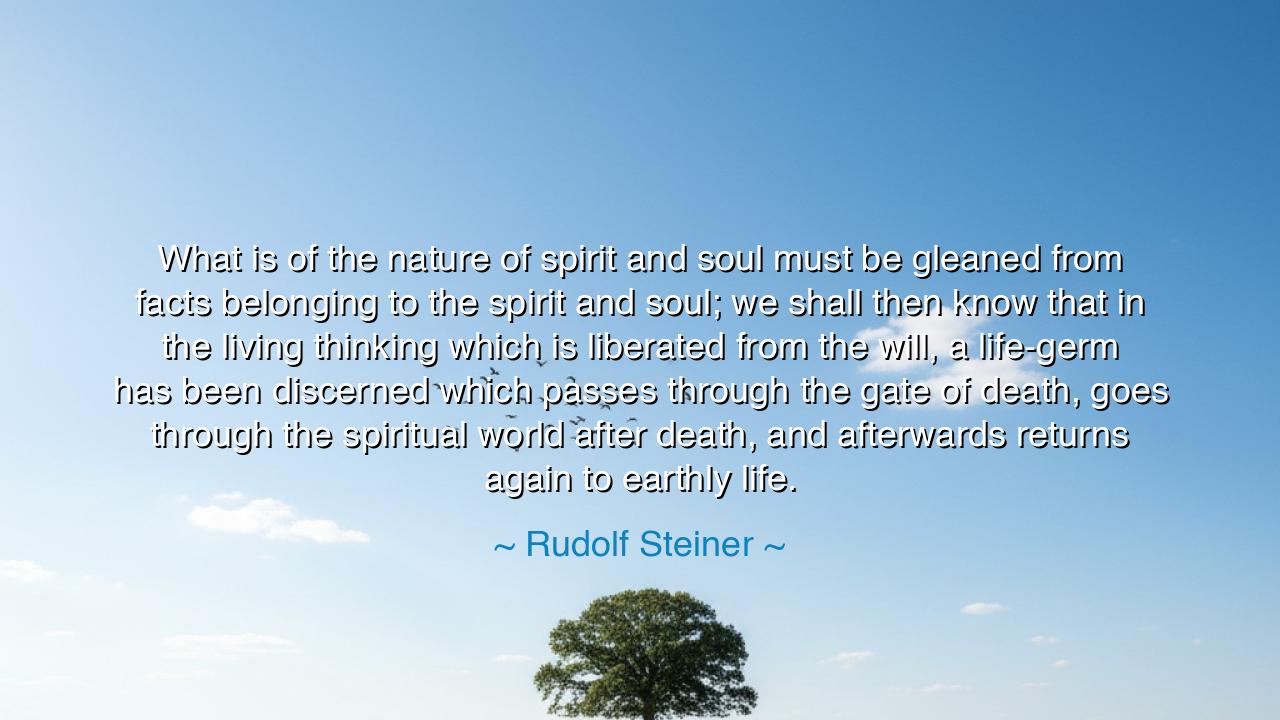
What is of the nature of spirit and soul must be gleaned from
What is of the nature of spirit and soul must be gleaned from facts belonging to the spirit and soul; we shall then know that in the living thinking which is liberated from the will, a life-germ has been discerned which passes through the gate of death, goes through the spiritual world after death, and afterwards returns again to earthly life.






In the luminous and mystical words of Rudolf Steiner, “What is of the nature of spirit and soul must be gleaned from facts belonging to the spirit and soul; we shall then know that in the living thinking which is liberated from the will, a life-germ has been discerned which passes through the gate of death, goes through the spiritual world after death, and afterwards returns again to earthly life,” we find a truth as profound as it is eternal. Steiner, philosopher and seer of the unseen, speaks not of abstract belief, but of a living reality—that the human soul is not bound by the limits of the body, nor extinguished by the event of death. He teaches that thought, when freed from the fetters of desire and action, becomes the eye through which eternity is glimpsed. Through this living thinking, one perceives the immortal current flowing beneath the fragile crust of mortal life.
The meaning of this quote rests upon Steiner’s central insight into the human condition: that man is not merely a creature of flesh and instinct, but a spiritual being who journeys through many worlds. The spirit and soul, he tells us, cannot be studied as one would study stone or bone, for they belong to another order of existence. They must be approached through their own language—through meditation, contemplation, and inner experience. When thought rises above the impulses of the body and the demands of the will, it becomes pure, self-sustaining, and alive. In that state, one begins to sense the life-germ, the seed of immortality, that passes through the gate of death and continues its pilgrimage through realms unseen, until it returns again to earth clothed in new form.
The origin of this teaching lies in Steiner’s spiritual science, or anthroposophy, which sought to unite the clarity of reason with the wisdom of the spirit. He believed that the soul’s journey could be approached not through blind faith, but through conscious perception. To him, thinking was not merely a tool of intellect, but a doorway to higher reality. When thought is freed from the desires of the ego, it becomes a mirror of the divine. Through this living, liberated thought, the human being perceives not only the temporal world but the eternal rhythm of death and rebirth—the sacred cycle by which the soul evolves, learns, and grows closer to the divine source from which it came.
This vision finds echoes in the teachings of the ancients. The Egyptians, too, believed that life and death were but phases of a single continuum. To them, the soul traveled through the Duat—the realm of spirits—where it was weighed and tested before returning to the realm of the living. Likewise, the Greek philosophers—Plato, Pythagoras, and others—spoke of the immortality of the soul, of its descent into flesh and ascent into light. Steiner’s words carry forward this lineage, reviving for modern humanity the forgotten truth that life is not a single spark extinguished by death, but a flame that renews itself through countless transformations.
We see this mystery embodied in the life of Joan of Arc, the young maiden who, guided by voices of spirit, defied kings and armies. Though her body perished in the fire, her spirit passed through the gate of death and continued to inspire nations. In her, as Steiner might say, the life-germ endured—the immortal essence that reappears in the hearts of all who act with courage born of faith. For what is death to one whose thoughts are aflame with divine purpose? The physical form may fall, but the spiritual essence, the living light within, journeys onward to weave new destinies and awaken sleeping souls.
Steiner’s teaching, then, is both metaphysical and moral. It calls upon us to cultivate that living thinking—to rise above the mechanical thought that serves appetite and ambition, and awaken to the spiritual reality that breathes within and beyond us. To think in such a way is to begin to know the soul not as concept, but as experience. In quiet meditation, in the stillness beyond desire, we may sense that there is something within us that does not age, that does not perish—the eternal traveler who gathers wisdom from every life and carries it into the next. This is the living spirit, the hidden thread that connects all beings across time.
So, dear listener, the lesson is this: awaken the part of yourself that thinks not for gain, but for truth. Seek knowledge not merely with the mind, but with the soul. When your thoughts are purified of ego and directed toward the eternal, they will reveal the immortal germ that dwells within you—the essence that passes through death unscathed, the seed that blossoms anew in every life. Live, then, not as one afraid of ending, but as one who knows that the journey is infinite and sacred.
For as Rudolf Steiner teaches, death is not a wall but a gate, and through that gate the soul walks only to find itself reborn. The task of man is not to fear this passage, but to prepare for it—to live each day as an apprentice of eternity. Through love, wisdom, and awakened thought, we may come to know the truth he spoke: that within every human heart beats the pulse of immortality, and within every act of living thought burns the spark of the divine everlasting.






AAdministratorAdministrator
Welcome, honored guests. Please leave a comment, we will respond soon